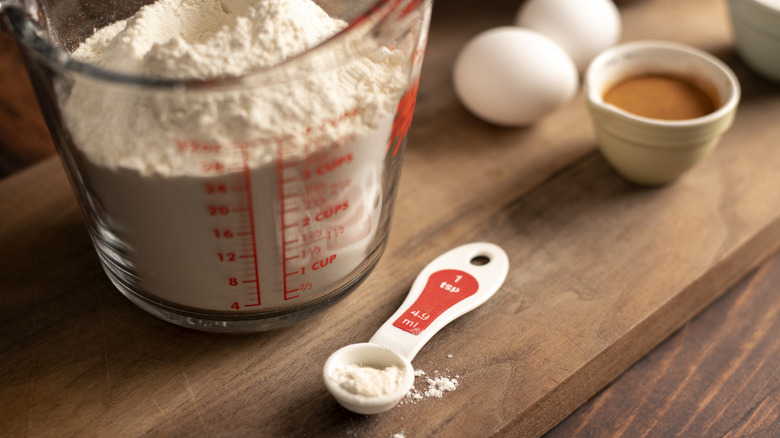Ina Garten's Simple Tip For More Precise Bakes
Ina Garten knows good cooking and she knows good cakes. The cookbook author and television personality has been guiding home cooks for decades. Her recipes are precise and often inventive, such as her her boozy, zesty twist on pound cake for example. And her work in the world of baking doesn't stop there. There is a whole catalogue of fantastic Ina Garten desserts. So you can trust her when she dispenses little nuggets of baking wisdom. And when it comes to baking with absolute precision, there is one bit of guidance that she absolutely swears by: using flour without leavening agents.
Garten revealed this bit of wisdom in an episode of "Barefoot Contessa" on Food Network during a segment displaying her recipe for double fudge cake. She noted that "you don't want a cake that's too light and you don't want one that's too dense. Just right." This is why she prefers not to use "...flour that has leavening in it, to do my own leavening." This means stepping away from the self-rising bag when baking, as these flours come with leavening ingredients in them and do not allow for control over the leavening process, which is key to consistent results. Using self-rising flour can lead to uneven bakes, which is not what you want when baking, say, a very important birthday cake. Using your own leavening agents will allow more precision, and also avoids the inclusion of other added ingredients, such as cream of tarter, which can further impact texture.
When to use self-rising flour and when to avoid it
Now, this is not to say that your should avoid using self-rising flour altogether. After all, there are some recipes that call for the ingredient, and which have proven to work well with leavening agents included in the flour itself. Foods such as beer breads, or simple quick breads like banana bread, often use self-rising flour. For these recipes, it might be a safe bet to use self-rising over all-purpose. However, if your recipe calls for specific amounts of leavening agents such as baking soda or baking powder, then you should not swap the flour out for the self-rising kind.
For instance, cookies and cakes have vastly different textures, and you'll want your cakes to rise in the pan and your cookies to maintain their shape. So, these recipes often have different proportions of leavening agents, which can't be used interchangeably. Additionally, there are some recipes that avoid leavening agents altogether, such as shortbreads and pie crusts, which simply would not work with self-rising flour. All-purpose flour makes for a better option here.
You will also want to avoid whisking in additional leavening agents when using self-raising flour, as this can lead to even more inconsistent results otherwise. So the next time you're puzzling over your flour options at the grocery store, you might want to reach for all-purpose flour over self-rising depending on what you're baking (or maybe grab both, we won't tell the Barefoot Contessa). Or, you can always buy all-purpose flour and turn it into self-rising flour using two pantry staples at home.

